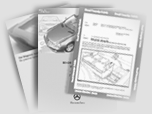|
 WARNING: Risk of Personal Injury! WARNING: Risk of Personal Injury!
MOVING COMPONENTS
When working on components which are moved by hand, by electric motor,
by hydraulic or pneumatic means via a connecting mechanism, severe injury
may be sustained as a result of severing, trapping or crushing of limbs.
Safety precautions for working with moving components:
 Keep the danger zone under
surveillance. Keep the danger zone under
surveillance.
 When moving components, protect
the range of mechanical movement against interference. When moving components, protect
the range of mechanical movement against interference.
 Do not reach into the mechanism
of a component while energizing electric motors via testers (HHT) or directly
via terminal 30. Do not reach into the mechanism
of a component while energizing electric motors via testers (HHT) or directly
via terminal 30.
Make sure that test cables are of sufficient length.
During work in the area of the roll bar, there is a risk of serious injury
should the roll bar suddenly deploy.
The roll-over sensors are integrated into the roll bar control module
(power soft top) (N52), the roll bar may be activated inadvertently during
diagnosis or maintenance work on N52.
Moreover, the roll bar may still be triggered up to 1 hour after the ignition
has been switched off. It is therefore not sufficient just to switch off
the ignition.
Precautions/rules for handling roll bars:
 Always monitor the danger
area. Always monitor the danger
area.
 Always raise the roll bar before
carrying out any work in its vicinity. Always raise the roll bar before
carrying out any work in its vicinity.
 Should it not be possible to raise
the roll bar due to a malfunction, the vehicle's battery (G1) must be
disconnected. Should it not be possible to raise
the roll bar due to a malfunction, the vehicle's battery (G1) must be
disconnected.
 Ensure that parts of the body
are kept a safe distance from the area in which the roll bar's mechanism
moves. Ensure that parts of the body
are kept a safe distance from the area in which the roll bar's mechanism
moves.
HYDRAULIC SYSTEMS
Serious injuries can be caused to the skin or eyes when loosening hydraulic
lines if the system is not previously depressurized due to the very high
pressures (above 200 bar). Damage to the skin may be caused if unprotected
skin comes into contact with hydraulic fluid, particularly central hydraulic
fluid (this is especially harmful to health).
Anyone who swallows hydraulic fluid can expect to suffer symptoms of poisoning
including headaches, dizziness, stomach ache, vomiting, diarrhea, cramps
and unconsciousness
Safety measures/operating instructions for working with hydraulic systems:
 Before starting work on hydraulic
systems they should be depressurized and the system must be emptied if
necessary. Before starting work on hydraulic
systems they should be depressurized and the system must be emptied if
necessary.
 Do not pour hydraulic fluid into
drinking containers. Do not pour hydraulic fluid into
drinking containers.
 Ensure adequate ventilation, particularly
in the case of central hydraulic fluid. Ensure adequate ventilation, particularly
in the case of central hydraulic fluid.
 Ensure only authorized persons
have access to hydraulic fluid. Ensure only authorized persons
have access to hydraulic fluid.
 Seal disconnected lines and hoses
and connections on the subassemblies immediately with blind plugs. Seal disconnected lines and hoses
and connections on the subassemblies immediately with blind plugs.
 Wear safety gloves, protective
clothing and safety glasses. Wear safety gloves, protective
clothing and safety glasses.
If it is not possible to wear safety gloves, the following points are
to be observed:
Only allow hydraulic fluid to come into contact with the skin for as short
a time as possible, wash fluid off skin with soap and water.
Change wet clothing as quickly as possible.
Notes for Hydraulic Tests:
Actuation using Hand Held Tester (HHT)
For actuation using the HHT, the contact of the power soft top test connector
(X11/12) must be routed to ground.
It is absolutely essential to remove the connection when the actuations
are completed.
Note:
X11/12 is located in the area of the data link connector (DTC readout)
(X11/4).
Visual inspection
To ensure that satisfactory visual inspection can be carried out in the
event of oil loss in the hydraulic system, the appropriate trim parts
and rear seat system are to be removed.
Bleeding soft top/roll bar hydraulic system
The hydraulic system bleeds itself automatically after the soft top is
operated 2-3 times.
Reducing pressure in the soft top/roll bar hydraulic system
The pressure in the soft top/roll bar hydraulic system may still be present
after taking a pressure measurement. There are 3 alternatives for reducing
pressure before unscrewing the test line:
 Close the soft top (manually if
necessary) but do not lock. Close the soft top (manually if
necessary) but do not lock.
Switch the ignition on and off again twice in quick succession.
 Connect HHT then connect contact
of power soft top test connector (X11/12) to vehicle ground. Connect HHT then connect contact
of power soft top test connector (X11/12) to vehicle ground.
Ignition: ON
Perform actuation, "pressure reducing".
Disconnect contact at power soft top test connector (X11/12) again.
 Ignition: OFF Ignition: OFF
Disconnect relay (A7/5k1) on the roll bar (RB) hydraulic unit (power soft
top) (A7/5) from the relay base.
Ignition: ON
Operate the RB switch (manual operation) (S83) or power soft top switch
(S84) briefly.
Note:
The position of the soft top is of no significance when reducing pressure
using the HHT or switches S83 and S84 as mentioned above.
|


 Printable
version
Printable
version


 Printable
version
Printable
version